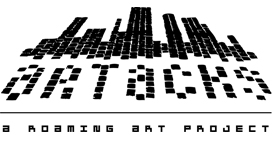About Urban Art
- Curator & member of «artacks»
Whether as a fast action on the street or in a relaxed studio’s atmosphere; exhibited at the White Cube or in the public space; illegal, legal, anonymous or numbered and signed; done byaerosol, brush or pencil; on concrete, paper, skate decks or canvas: «Urban Art» is virulent in the most different contexts, it is based on a wide range of techniques and it appears on ever changing surfaces. Its protagonists master the balancing act between public and private space, subculture, mainstream and fine art, they take hold of the virtual and real spaces and they supply fans, art collectors, critics and «innocent» pedestrians with art, that emerges as created for the moment, numerously reproduced or even as an expensive original behind glass.
It is the urban space with its external structures, its rough edges, and even more so its inner, subcultural drive over the course of the last 40 years – in graffiti writing, hip hop, skateboarding, comic, punk rock or street art – that coins, inspires and involves this generation of artists. It is the urban space that delivers them with ideas and fills their work with serious topics as well as funny nonsense... The Urban Space forms their common denominator.
And beyond the street? «Urban Art» in exhibitions and galleries isn’t a new thing - it's just a new expression for a quiet old phenomenon. Already back in the Seventies and increasingly so in the Eighties graffiti has attracted the attention of the art world and the mainstream culture. Its protagonists have been celebrated and pushed into art galleries. But the resulting product «spraypaint on canvas» wasn’t viable. These days, the short connection between graffiti and fine art ended up abruptly and their paths went separate ways…
Since then graffiti emancipated, differentiated and transformed itself. New influences arrived, younger protagonists took the field while some of the older ones oriented themselves new and began to find challenges beyond the streets, where the «cryptic» graffiti was more and more competed by the «Bilderflut» of street art. As a «new» phenomena street art won over the urban space and at the beginning of the new millennium it culminated into a real hype. Hence, new problems were caused. Nevertheless, the signs for an artistic career of its protagonists were better, this time.
On one hand, a growing and constantly further developing «Urban Art» scene is created in a global extent, including galleries, magazines, independent projects and of course an interested public. «Urban Art» enables them to clash, to find aesthetic and substantial links and lets them relate to those. Artists and the public are talking the same language, they’re meeting at eye level and they tie broader networks than ever.
Today the artists are acting at an increased level of professionalism. They often dispose profound creative educations, are partly experienced designers, are self-confident and still abide by their roots and principles – briefly: they are authentic. Their extraordinary talents and abilities paired with the processing of complex urban topics conducts the established art world to a more increased interest. The potential of «Urban Art» is huge!
- Curator & member of «artacks»

